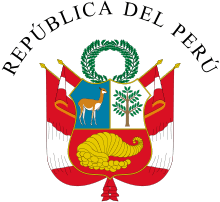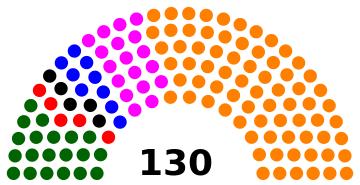Elections in Peru
In Peru, the people directly elect a head of state (the president) as well as a legislature. The president is elected by the people for a five-year term. The unicameral Congress (Congreso) has 130 members, also elected for a five-year term by proportional representation. Peru has a multi-party system, which effectively bars one party from becoming the sole influence in a decision-making process. As such, parties must work with one another to form coalition governments. The whole election process is held by the National Jury of Elections and the National Office of Electoral Processes. Peru has compulsory voting.[1][2]
 |
|---|
| This article is part of a series on the politics and government of Peru |
| Constitution |
|
|
|
|
Autonomies
|
|
|
|
|
|
|
Schedule
Election
| Position | 2016 | 2017 | 2018 | 2019 | 2020 | 2021 |
|---|---|---|---|---|---|---|
| Type | Presidential (April & June) National Congress (April) Gubernatorial (April & June) | None | Presidential (April & June) National Congress (April) Gubernatorial (April & June) | |||
| President and vice president |
President and vice president | None | President and vice president | |||
| National Congress | All seats | None | All seats | |||
| Provinces, cities and municipalities | All positions | None | All positions | |||
Inauguration
| Position | 2016 | 2017 | 2018 | 2019 | 2020 | 2021 |
|---|---|---|---|---|---|---|
| Type | Presidential (May) National Congress (May) Gubernatorial (May) | None | Presidential (May) National Congress (May) Gubernatorial (May) | |||
| President and vice president |
28 July | None | 28 July | |||
| National Congress | 28 July | None | 28 July | |||
| Provinces, cities and municipalities | 28 July | None | 28 July | |||
Latest elections
Presidential election
The first round was held on 10 April. Exit polls indicated that Keiko Fujimori placed first in the first round of voting with approximately 40% of the vote, with Pedro Pablo Kuczynski and Veronika Mendoza each receiving approximately 20%.[3]
The second round was held on 5 June. Exit polls indicated that Pedro Pablo Kuczynski held a slight lead over Keiko Fujimori. As counting continued, the gap narrowed significantly. Preliminary results gave Kuczynski a 0.25 per cent advantage over Fujimori, with less than 50,000 votes between them. Approximately 50,000 votes were challenged during the count.[4] Fujimori conceded the election to Kuczynski on 10 June.[5]
| Candidate | Party | First round | Second round | |||
|---|---|---|---|---|---|---|
| Votes | % | Votes | % | |||
| Keiko Fujimori | Popular Force | 6,115,073 | 39.86 | 8,555,880 | 49.88 | |
| Pedro Pablo Kuczynski | Peruvians for Change | 3,228,661 | 21.05 | 8,596,937 | 50.12 | |
| Verónika Mendoza | Broad Front | 2,874,940 | 18.74 | |||
| Alfredo Barnechea | Popular Action | 1,069,360 | 6.97 | |||
| Alan García | Popular Alliance | 894,278 | 5.83 | |||
| Gregorio Santos | Direct Democracy | 613,173 | 4.00 | |||
| Fernando Olivera | Hope Front | 203,103 | 1.32 | |||
| Alejandro Toledo | Possible Peru | 200,012 | 1.30 | |||
| Miguel Hilario | Developing Peru | 75,870 | 0.49 | |||
| Antero Flores Aráoz | Order Party | 65,673 | 0.43 | |||
| Invalid/blank votes | 3,393,987 | – | 1,190,079 | – | ||
| Total | 18,734,130 | 100 | 18,342,896 | 100 | ||
| Registered voters/turnout | 22,901,954 | 81.80 | 22,901,954 | 80.09 | ||
| Source: ONPE, ONPE | ||||||
Parliamentary election
Popular Force won in a landslide, taking more than a third of the vote and an absolute majority of 73 out of 130 seats. Behind them in opposition, Peruvians for Change with 18 seats and Broad Front with 20 seats. Other parties which gained representation in Congress include Alliance for the Progress of Peru (9 seats), Popular Alliance (5 seats) and Popular Action (5 seats).[6]
 | |||||
| Party | Vote | % | Seats | ||
|---|---|---|---|---|---|
| Popular Force | 4,431,077 | 36.34 | 73 | ||
| Peruvians for Change | 2,007,710 | 16.47 | 18 | ||
| Broad Front | 1,700,052 | 13.94 | 20 | ||
| Alliance for the Progress of Peru | 1,125,682 | 9.23 | 9 | ||
| Popular Alliance | 1,013,735 | 8.31 | 5 | ||
| Popular Action | 877,734 | 7.20 | 5 | ||
| Direct Democracy | 528,301 | 4.33 | 0 | ||
| Possible Peru | 286,980 | 2.35 | 0 | ||
| Hope Front | 139,634 | 1.15 | 0 | ||
| Order Party | 68,474 | 0.56 | 0 | ||
| Developing Peru | 14,663 | 0.12 | 0 | ||
| Invalid/blank votes | – | – | |||
| Total | 12,194,042 | 100 | 130 | ||
| Registered voters/turnout | 22,901,954 | 53.24 | – | ||
| Source: ONPE | |||||
Laws
- Sale of alcohol and carrying firearmes (except for Members of the Armed Forces and the National Police) are forbidden during an election.
- Political gatherings are forbidden, while public gatherings of any sort are prohibited during voting hours, including religious liturgies and entertainment shows. Clergy of any religion can not participate in their distinctive garments or habits.
See also
- National Jury of Elections
- National Office of Electoral Processes
- Electoral calendar
- Electoral system
References
- <Staff writer(s); no by-line. (5 June 2016). presidential-runoff-vote-starts-peru-39619860 "The Latest: Presidential Runoff Vote Starts in Peru" Check
|url=value (help). ABC News. Lima, Peru. The Associated Press. Retrieved 5 June 2016.Voting is mandatory in Peru.
- Jason Brennan; Lisa Hill (12 June 2014). Compulsory Voting: For and Against. Cambridge University Press. p. 116. ISBN 978-1-107-04151-6.
- "Peru election: Keiko Fujimori wins first round, say exit polls – BBC News". BBC News. Retrieved 2016-04-11.
- "Peru election: Kuczynski wins, but Fujimori has yet to concede". BBC News. Retrieved 11 June 2016.
- "Peru elections: Keiko Fujimori concedes to Kuczynski". BBC News. Retrieved 11 June 2016.
- "ELECTION FOR CONGRESO DE LA REPÚBLICA 2016". Retrieved 1 June 2016.